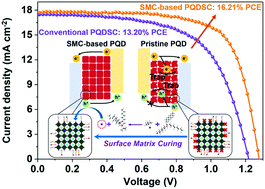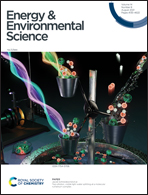Surface matrix curing of inorganic CsPbI3 perovskite quantum dots for solar cells with efficiency over 16%†
Abstract
Inorganic CsPbI3 perovskite quantum dots (PQDs) show high potential for photovoltaic applications. However, the surface matrix of the PQDs significantly suffers from deterioration during the purification process with antisolvent, significantly affecting their optoelectronic properties and stability. Herein, a “surface matrix curing” (SMC) strategy is introduced to restore the surface matrix of CsPbI3 PQDs. The PQD surface matrix with iodide vacancies was substantially restored using the nucleophilic substitution reaction of tert-butyl iodide (TBI) and nucleophile trioctylphosphine (TOP), which could produce sufficient iodide ions to fill in the iodide vacancies of the PQD surface matrix. With this strategy, the optoelectronic properties and stability of the PQDs were significantly improved. As a result, the PQD solar cell (PQDSC) yielded an improved power conversion efficiency of 16.21% (stabilized power output efficiency of 15.45%), which is the highest value among inorganic CsPbI3 PQDSCs. The improved photovoltaic performance in PQDSCs was attributed to significantly suppressed charge carrier recombination induced by the surface defects of the PQDs. This work provides important insights into the surface chemistry of PQDs and offers a new avenue to realize high-performing PQD optoelectronic devices.



 Please wait while we load your content...
Please wait while we load your content...